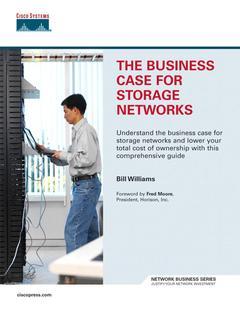Description
Business case for storage networks
Author: Williams Bill
Language: English
Approximative price 39.49 €
Subject to availability at the publisher.
Add to cart250 p. · 17.7x23 cm · Paperback
Description
/li>Contents
/li>
- Written for ANY businessperson--no technical experience required!
- Learn what storage networks are and what they can do for your network
- Includes ROI, TCO, and EVA metrics to evaluate your Storage Area Network (SANs) solution
- Compare SAN implementation strategies
- Review case studies of companies that have already rolled out SANs
I. THE STORAGE NETWORKING VALUE PROPOSITION.
1. Industry Landscape: Storage Costs and Consumption.
Storage Management Matters.
Implementing a Storage Vision.
Irrational Exuberance.
Macro Sources of Economic Downturn.
Commoditization of Hardware.
The Disk as Commodity.
The Server as Commodity.
The Impact of Competition on IT.
The Impact of Legislation on IT.
Regulation Fair Disclosure.
Sarbanes-Oxley.
Health Insurance Portability and Accountability Act of 1996.
Title 21.
Securities and Exchange Commission.
Utilization and Yield.
The Cost of Poor Quality and the Storage Problem.
Storage Yield.
Obstacles Inherent in DAS.
Utilization.
Conclusion.
Summary.
End Notes.
2. The Business Impact of Storage Networking Technology.
Tangible and Intangible Benefits of Storage Networking.
Technology Solutions Associated with Storage Networking.
Increased Availability.
Backup and Recovery Options.
LAN-Free Backups.
Server-Free Backups.
Replication.
Asynchronous Replication.
Synchronous Replication.
SAN Extensions.
Optical Networking.
Fibre Channel over Internet Protocol.
Internet Fibre Channel Protocol.
Internet SCSI.
Total Cost of Ownership.
Conclusion.
End Notes.
3. Building a Value Case Using Financial Metrics.
Using Payback, ROI, NPV, and EVA.
Payback Method.
Return on Investment.
Net Present Value.
Economic Value Added.
Value Case Analysis.
DAS-to-SAN Migration Value Case.
Storage Consolidation Value Case.
DAS-to-NAS Migration Value Case.
iSCSI Implementation Value Case.
Conclusion.
End Notes.
4. How it Should Be Done: Implementation Strategies and Best Practices.
Technology Adoption.
Storage Technology Primer.
TCO, Tiered Storage, and Capacity Planning.
Information Lifecycle Management.
Performance Planning.
Oversubscription.
Core Topology.
Core-Edge Topology.
Redundancy and Resiliency.
Choosing the Right Vendor.
Request for Information (RFI).
RFP/RFQ.
Changing the Support Model Paradigm.
Networking and IP Transport Model.




